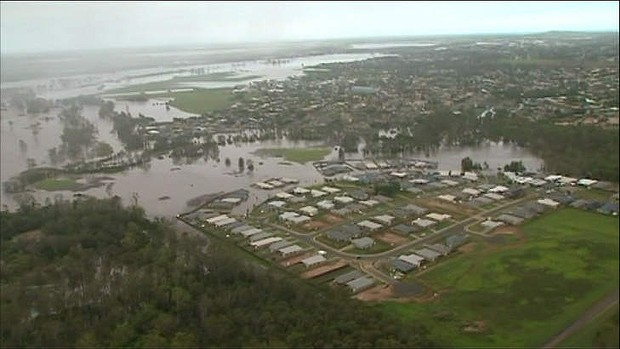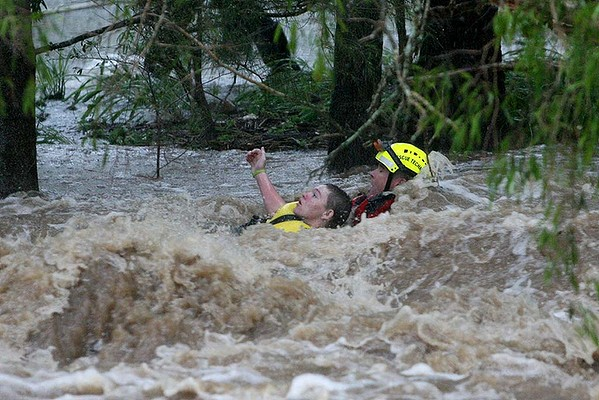Four dead, two missing as heavy rain ravages Australia coast – ‘It was supposed to be a one-in-100-year flood, not a one-in-two-year flood’
By Ilya Gridneff, Nicole Hasham, and Amy Remeikis
29 January 2013 (Sydney Morning Herald) – A week after some of the hottest temperatures on record, four Queenslanders are dead and two men remain missing as winds and torrential rain lash the east coast and flooding wreaks havoc in parts of northern NSW. Ex-tropical cyclone Oswald has brought strong winds and constant rain that has isolated parts of Queensland and the northern rivers area of NSW, with 500 homes in Lismore evacuated on Monday night. The SES also issued evacuation orders for Ulmarra, Cowper, and Brushgrove. […] The storm front was expected to move south to the Sydney metropolitan area in the early hours of Tuesday, bringing more wild weather. The Queensland Premier, Campbell Newman, said the next 24 hours would see flood peaks in the Lockyer Valley, Ipswich and Brisbane. ‘‘We’re not going to forget people; there will be a very strong recovery effort,’’ he told ABC TV. Sean Scott, of Ipswich, headed to an evacuation centre after police warned that his home could flood. “I don’t have much, but I made sure I moved my ute somewhere safe. I’ve got no job without my ute,” he said. […] Grafton has been hit by a major flood and a new warning was issued for Murwillumbah and Chinderah as the Tweed River catchment flooded on Monday. Queensland was hit the hardest, with Bundaberg suffering its worst flood on record. Helicopters rescued residents trapped on their rooftops and it is believed 1200 homes were damaged by the flood. People living along the Logan and Albert rivers south of Brisbane were warned to prepare for flooding. Senior Sergeant Grant Marcus, the executive officer of Bundaberg District Disaster Management, said as many as 1000 people in north Bundaberg had been taken to safety by Black Hawk helicopter. West of Brisbane, in the Lockyer Valley, where floods took 19 lives in 2011, evacuations have been carried out as flood levels exceeded previous levels. [more]
Four dead, two missing as heavy rain ravages coast 
By Peter Hannam, Carbon economy editor
29 January 2013 (Sydney Morning Herald) – ONE of the biggest storm systems in decades was expected to hit the Sydney region overnight, potentially causing havoc for students and employees returning from their summer holidays. Julie Evans, a senior meteorologist at the weather bureau, said 100-200 millimetres of rain was forecast to hit the city, much of it landing in the six hours to 6am on Tuesday. “It could be pretty nasty in the morning peak hour,” she said. Ben McBurney, a meteorologist at Weatherzone, said the scale of the storm – the remnants of former tropical cyclone Oswald – was a “10- to 20-year event”. “It’s been fed constantly by moist north-easterly winds off the Coral Sea,” he said. “Certainly its longevity has been quite remarkable. Not many people picked that this was going to last all the way from north Queensland down to the NSW coast.” Ms Evans said climate experts calculated that three-day rainfall totals could challenge those of a big storm from tropical cyclone Zoe in March 1974. “Our flood people are watching 13 different river catchments,” she said. “It’s that sort of system that we’ve had to monitor a huge area because of the likely breadth of it.” In Sydney, the Cooks River flowing into Botany Bay was one area under watch. Wind gusts were also expected to lash more of the state as the deep low-pressure system moved south. For Sydney, though, the strongest winds were likely to be confined to the coastal fringe. Surf conditions were likely to remain dangerous, with waves reaching as high as 10 metres off Coffs Harbour. The wetter conditions have brought some cheer, though, with at least 50 millimetres of rain at Coonabarabran, near large fires in the state’s north-west. “You go from one extreme to the other,” said Weatherzone’s Mr McBurney. The next extreme, however, may be another heatwave, stretching from Adelaide to Sydney and Brisbane. “Our indications are that mid- to late-February is going to be quite warm,” he said.
Storm surge: summer holidays end with a bang 
By Bridie Jabour and Ilya Gridneff
29 January 2013 (Sydney Morning Herald) – Emergency crews scrambled on Monday to rescue up to 1500 people feared trapped in Bundaberg as Queensland’s flood crisis grew. A week after Australia had some of the hottest temperatures on record, four Queenslanders were confirmed dead and another two were missing after ex-tropical cyclone Oswald brought strong winds and constant rain that isolated parts of central and south-east Queensland and northern parts of New South Wales. About 250,000 customers were without power in Queensland. Bundaberg, which faced record water levels, was the state’s hardest hit city. Emergency teams backed by 14 helicopters, including two Black Hawks, worked into the evening to ensure everyone left North Bundaberg. Queensland Premier Campbell Newman said the group of rescue helicopters, which were on standby throughout the night, could carry more than 80 people at a time. Mr Newman said the government estimated about 1500 people were trapped after staying despite a mandatory evacuation order issued on Monday morning to 5000 people in the area. Bundaberg was now in ‘‘uncharted territory’’, he said. By Monday afternoon, more than 2000 properties had been affected by floodwaters moving at more than 70km/h. Authorities said the Burnett River was at 9.2 metres and rising fast towards its expected peak of 9.5 metres on Tuesday. That would be well beyond the levels recorded in 2010-11 and in 1942, when the record was set. Residents of the Queensland town of Warwick were anxiously watching the rising Condamine River on Monday night, with 30 homes flooded and more expected to go under. A major flood crisis was developing in the state’s Lockyer Valley, where 19 lives were lost in the 2011 floods. Gympie and Maryborough were also under water. In Brisbane, a disaster declaration was made late on Monday ahead of the flood’s expected peak at noon on Tuesday. […] ‘‘Once again, sadly Queensland is facing a major disaster crisis,’’ the he said in Brisbane.
‘‘[But] this state and its people will rise to the challenge. Together we will get through this.’’ Hundreds of people were sheltering in an Ipswich evacuation centre as the swollen Bremer River continued to rise after breaking its banks. ‘‘It’s a sea of emotion here,’’ Ipswich mayor Paul Pisasale, who spoke with anxious residents bunkered down in evacuation centres, said. ‘‘To have the same people go through this again after just rebuilding their homes is terrible. What they’re feeling, what the kids are feeling … it’s all bad. ‘‘It was supposed to be a one-in-100-year flood, not a one-in-two-year flood.’’ [more]
